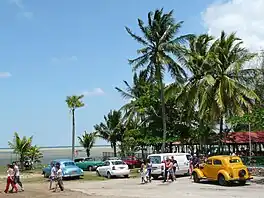| Laguna de Leche | |
|---|---|
 Touristic venue at Laguna de Leche | |
 Laguna de Leche | |
| Location | Cuba |
| Coordinates | 22°12′33″N 78°37′17″W / 22.20917°N 78.62139°W |
| Primary outflows | Bay of Buena Vista |
| Basin countries | Cuba |
| Max. length | 14 km (8.7 mi) |
| Max. width | 7.7 km (4.8 mi) |
| Surface area | 67.2 km2 (25.9 sq mi) |
| Surface elevation | 1 m (3.3 ft) |
| Settlements | Morón |
Laguna de Leche (Spanish for "Milk Lagoon", also called Laguna Grande de Morón) is the largest natural fresh water lake in Cuba. It is located in the wetland of northern Ciego de Ávila Province, 5 km (3.1 mi) north of Morón, and has a total surface of 67.2 square kilometres (25.9 sq mi). (The man-made Zaza Reservoir, at 113.5 km2 (43.8 sq mi), is the largest in-land water surface by area in the country.)
Overview
The white color is caused by the lake's limestone bed. Natural movements of the sea level cause disturbances in the water table, which releases lime particles from the lake bed into the water.[1]
A channel built in 1940 (Chicola Channel) connected the lake to the Bay of Buena Vista, allowing for the sugar processed in Morón to reach the small port of Chicola.[2] In the process, the lake was contaminated with sea water, and it lost its characteristic white color. The channel was closed in 1988, and the milky color gradually recovered.
The Caribbean flamingo finds a natural habitat in the lake and its islands
See also
References
- ↑ "Leche Lagoon". Encyclopædia Britannica. Retrieved 2007-10-12.
- ↑ Radio Morón. "The treasure of Laguna de la Leche" (in Spanish). Archived from the original on February 17, 2006. Retrieved 2007-10-12.